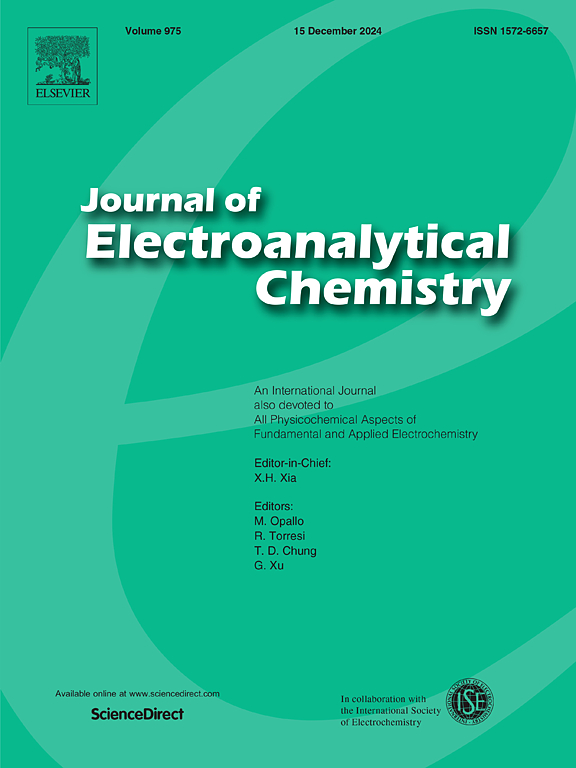碳布原位合成PtZnCu纳米合金用于超灵敏电化学氨氮检测
IF 4.1
3区 化学
Q1 CHEMISTRY, ANALYTICAL
引用次数: 0
摘要
纳米合金材料在氨氮电化学传感器研究领域中表现出优异、灵敏的性能,得到了研究者的广泛应用。采用一步电沉积法制备了基于碳布衬底的PtZnCu- cc三元纳米合金电极。表征结果表明,Zn、Cu和Pt的合金化调节了Pt的电子结构,增强了Pt对氨氮的电催化氧化能力。同时,通过密度泛函理论(DFT)证明,PtZnCu纳米合金充分继承了PtCu和PtZn纳米合金的优点,不仅提高了氨的吸附能力,而且平衡了各步的自由能。最后,提高了整个电极对氨氮的灵敏度。基于PtZnCu-CC电极的氨氮传感器线性检测范围为0.5 ~ 1000 μM,灵敏度为23.9 μA μM−1 cm−2,检出限(LOD)为8.37 nM,具有良好的重复性、抗干扰性和稳定性。该工作为设计高性能电化学传感器提供了明确的方向。本文章由计算机程序翻译,如有差异,请以英文原文为准。

In-situ synthesized PtZnCu nanoalloy on carbon cloth for ultrasensitive electrochemical ammonia-nitrogen detection
Nanoalloy materials showed excellent, sensitive properties in the research field of ammonia‑nitrogen electrochemical sensors, which have been widely used by researchers. The PtZnCu ternary nanoalloy electrode based on a carbon cloth substrate (PtZnCu-CC) was prepared using one-step electrodeposition. The characterization results showed that the alloying of Zn, Cu and Pt regulated the electronic structure of Pt and enhanced the electrocatalytic oxidation capacity of Pt for ammonia‑nitrogen. Meanwhile, it was proved by density functional theory (DFT) that PtZnCu nanoalloy fully inherited the advantages of PtCu and PtZn nanoalloy, which not only enhanced the adsorption capacity of ammonia but also balanced the free energy of each step. Finally, the sensitivity of the whole electrode to ammonia‑nitrogen was improved. The linear detection range of the sensor based on PtZnCu-CC electrode for ammonia‑nitrogen was 0.5–1000 μM, the sensitivity was 23.9 μA μM−1 cm−2, and the limit of detection (LOD) was 8.37 nM, which showed satisfactory repeatability, anti-interference and stability. This work provided a specific direction for designing high-performance electrochemical sensors.
求助全文
通过发布文献求助,成功后即可免费获取论文全文。
去求助
来源期刊
CiteScore
7.80
自引率
6.70%
发文量
912
审稿时长
2.4 months
期刊介绍:
The Journal of Electroanalytical Chemistry is the foremost international journal devoted to the interdisciplinary subject of electrochemistry in all its aspects, theoretical as well as applied.
Electrochemistry is a wide ranging area that is in a state of continuous evolution. Rather than compiling a long list of topics covered by the Journal, the editors would like to draw particular attention to the key issues of novelty, topicality and quality. Papers should present new and interesting electrochemical science in a way that is accessible to the reader. The presentation and discussion should be at a level that is consistent with the international status of the Journal. Reports describing the application of well-established techniques to problems that are essentially technical will not be accepted. Similarly, papers that report observations but fail to provide adequate interpretation will be rejected by the Editors. Papers dealing with technical electrochemistry should be submitted to other specialist journals unless the authors can show that their work provides substantially new insights into electrochemical processes.

 求助内容:
求助内容: 应助结果提醒方式:
应助结果提醒方式:


